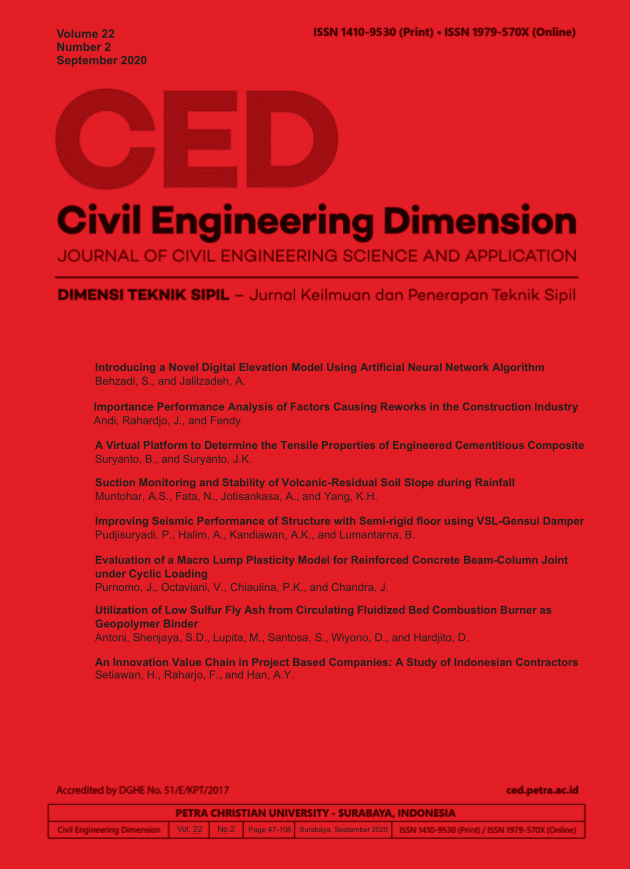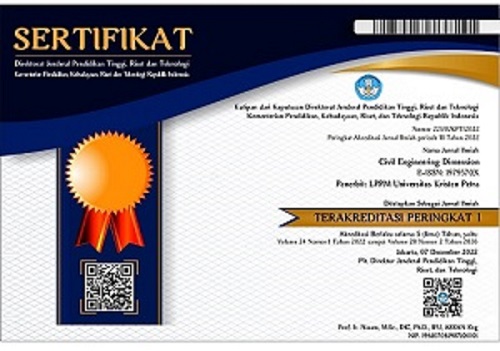Utilization of low sulfur fly ash from circulating fluidized bed combustion burner as geopolymer binder
 :
:
https://doi.org/10.9744/ced.22.2.93-97
Abstract
Circulating fluidized bed combustion (CFBC) is a newer type of burner that employ a circulating process to burn fuel effectively. CFBC burning process is gaining more popularity due to its compact size, high efficiency and lower burning temperature compared to the pulverized coal combustion (PCC) burner. The CFBC burner produces fly ash with different physical properties compared to the PCC burner, i.e. the fly ash is not rounded, and required higher water content for comparable workability. The CFBC fly ash also has a high sulfur content that is detrimental for hardened concrete. Due to its drawbacks, the CFBC hardly used as cementitious material and geopolymer precursor. This study focuses on comparing variations in the concentration of NaOH solution and variations in the ratio of alkaline activators to the setting time and compressive strength of geopolymer mortars on a new class of CFBC fly ash, which have low sulfur content. The concentrations of NaOH solution were 6M, 8M, 10M, and 12M, while the alkaline activator ratios used were 3.0, 2.5, 2.0, 1.0, and 0.5. It was concluded that the low sulfur CFBC fly ash has a potential to be utilized as geopolymer precursor, however, with a shortcoming in its high water demand. The CFBC fly ash used in this study resulted in a geopolymer matrix with good compressive strength and stability. The water demand varies with the fly ash sampling time shows the challenges in the utilization of the fly ash. The highest mortar’s compressive strength, 33.4 MPa at 90 days was achieved at NaOH concentration of 8M and ratio of sodium silicate solution to sodium hydroxide solution of 2.5 with excellent stability.
References
Hardjito D, Wallah S E, Sumajouw D M J and Rangan B V 2004 On the Development of Fly Ash-Based Geopolymer Concrete ACI Mater. J. 101 467–72
The National Coal Council 2006 Coal : America’s Energy Future (Washington DC: The National Coal Council)
Basu P and Fraser S A 1991 Circulating fluidized bed boilers (Springer)
Chi M, Huang R, Wu T and Fou T 2015 Utilization of circulating fluidized bed combustion ( CFBC ) fly ash and coal-fired fly ash in Portland cement Key Eng. Mater. 629–630 306–13
Robl T, Mahboub K, Stevens W and Rathbone R 2010 Fluidized Bed Combustion Ash Utilization : CFBC Fly Ash as a Pozzolanic Fluidized Bed Combustion Ash Utilization : CFBC Fly Ash as a Pozzolanic Additive to Portland Cement Concrete . Second International Conference on Sustainable Construction Materials and Technology
Wang C, Jia L, Tan Y and Anthony E J 2008 Carbonation of fly ash in oxy-fuel CFB combustion Fuel 87 1108–14
Chindaprasirt P, Rattanasak U and Jaturapitakkul C 2011 Utilization of fly ash blends from pulverized coal and fluidized bed combustions in geopolymeric materials Cem. Concr. Compos. 33 55–60
Shi G C, Xiao J L, Qun Y W, Lu J T and Ya J W 2017 Influence of Alkali activator Dosage on Strength of CFBC Fly Ash Based Geopolymer 2017 World of Coal Ash (WOCA) Conference (Lexington)
Donthuam P, Sawangwong P and Pachana P 2016 Effect of Fluidized Bed Coal Combustion Fly Ash on Geopolymer ’ s Properties IOSR J. Environ. Sci. Toxicol. Food Technol. 10 91–6
Hardjito D, Rangan B V, Wallah S E and Sumajouw D M 2005 Studies on Fly Ash-Based Geopolymer Concrete (Curtin University)
Antoni, Wijaya S W and Hardjito D 2016 Compressive strength of geopolymer based on the fly ash variation Mater. Sci. Forum 841 98–103
Zhang Z H, Yang T and Wang H 2014 The effect of efflorescence on the mechanical properties of fly ash-based geopolymer binders 23rd Australasian Conference on the Mechanics of Structures and Materials (ACMSM23) vol I pp 107–12
Zhang Z, Wang H, Provis J L and Reid A 2013 Efflorescence : A Critical Challenge for Geopolymer Applications ? Concrete Institute of Australia’s Biennial National Conference 2013 pp 1–10
ASTM C187 2016 Standard Test Method for Amount of Water Required for Normal Consistency of Hydraulic Cement Paste (West Conshohocken, PA: ASTM International)
ASTM C191 2018 Standard test method for time of setting of hydraulic cement by Vicat needle (ASTM International, West Conshohocken, PA)
ASTM C 1437-07 2009 Standard Test Method for Flow of Hydraulic Cement Mortar Annu. B. ASTM Stand. 6–7
ASTM D5239 2012 Standard practice for characterizing fly ash for use in soil stabilization vol 04 (ASTM International, West Conshohocken, PA)
Salain I M A K 2010 Study on Reactivity of Circulating Fluidized Bed Combustion Fly Ashes in the Presence of Water Civ. Eng. Dimens. 12 29–35
Li F, Zhai J, Fu X and Sheng G 2006 Characterization of fly ashes from circulating fluidized bed combustion (CFBC) boilers cofiring coal and petroleum coke Energy and Fuels 20 1411–7
Silva L F O, Oliviera M L S, Kautzmann R M, Ramox C G, Izquierdo M, Dai S, Wilcox J, Hoffman J and Hower J C 2014 Geochemistry and Mineralogy of Coal-Fired Circulating Fluidized Bed Combustion Fly Ashes
Antoni, Wibiatma Wijaya S and Hardjito D 2016 Factors Affecting the Setting Time of Fly Ash - Based Geopolymer Mater. Sci. Forum 841 90–7
Lăzărescu A V, Szilagyi H, Baeră C and Ioani A 2017 The Effect of Alkaline Activator Ratio on the Compressive Strength of Fly Ash-Based Geopolymer Paste IOP Conf. Ser. Mater. Sci. Eng. 209 012064
Downloads
Published
How to Cite
Issue
Section
License
Authors who publish with this journal agree to the following terms:- Authors retain the copyright and publishing right, and grant the journal right of first publication with the work simultaneously licensed under a Creative Commons Attribution License that allows others to share the work with an acknowledgement of the work's authorship and initial publication in this journal.
- Authors are able to enter into separate, additional contractual arrangements for the non-exclusive distribution of the journal's published version of the work (e.g., post it to an institutional repository or publish it in a book), with an acknowledgement of its initial publication in this journal.
- Authors are permitted and encouraged to post their work online (e.g., in institutional repositories or on their website) followingthe publication of the article, as it can lead to productive exchanges, as well as earlier and greater citation of published work (See The Effect of Open Access).

















